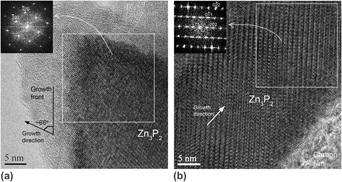Crossref Citations
This article has been cited by the following publications. This list is generated based on data provided by
Crossref.
Carenco, Sophie
Portehault, David
Boissière, Cédric
Mézailles, Nicolas
and
Sanchez, Clément
2013.
Nanoscaled Metal Borides and Phosphides: Recent Developments and Perspectives.
Chemical Reviews,
Vol. 113,
Issue. 10,
p.
7981.
Kamimura, H
Gouveia, R C
Dalmaschio, C J
Leite, E R
and
Chiquito, A J
2014.
Synthesis and electrical characterization of Zn3P2nanowires.
Semiconductor Science and Technology,
Vol. 29,
Issue. 1,
p.
015001.
Bae, In-Tae
Jung, Dae Young
Chen, William T.
Chen, Scott
and
Chang, Jenny
2014.
Comprehensive transmission electron microscopy study on Cu–Al intermetallic compound formation at wire bond interface.
Journal of Materials Research,
Vol. 29,
Issue. 23,
p.
2787.
Lee, Sudarat
Fahrenkrug, Eli
and
Maldonado, Stephen
2015.
Synthesis of photoactive ZnSnP2 semiconductor nanowires.
Journal of Materials Research,
Vol. 30,
Issue. 14,
p.
2170.
Pradhan, Bapi
Kumar, Gundam Sandeep
Dalui, Amit
Khan, Ali Hossain
Satpati, Biswarup
Ji, Qingmin
Shrestha, Lok Kumar
Ariga, Katsuhiko
and
Acharya, Somobrata
2016.
Shape-controlled cobalt phosphide nanoparticles as volatile organic solvent sensor.
Journal of Materials Chemistry C,
Vol. 4,
Issue. 22,
p.
4967.
Bouzara, C.
Kaci, S.
Boukezzata, A.
Kezzoula, F.
Bozetine, I.
Keffous, A.
Trari, M.
Manseri, A.
Menari, H.
Azzouz, R.
Leitgeb, M.
Ouadfel, M.-A.
Talbi, L.
Benfadel, K.
and
Ouadah, Y.
2019.
Study of Optical Properties of Nanocrystalline Zinc Phosphide Thin films.
Silicon,
Vol. 11,
Issue. 1,
p.
331.
Dzade, Nelson Y.
2020.
First-Principles Insights into the Interface Chemistry between 4-Aminothiophenol and Zinc Phosphide (Zn3P2) Nanoparticles.
ACS Omega,
Vol. 5,
Issue. 2,
p.
1025.
Paredes, Ingrid J.
Beck, Clara
Lee, Scott
Chen, Shuzhen
Khwaja, Mersal
Scimeca, Michael R.
Li, Shuang
Hwang, Sooyeon
Lian, Zhen
McPeak, Kevin M.
Shi, Su-Fei
and
Sahu, Ayaskanta
2020.
Synthesis of luminescent core/shell α-Zn3P2/ZnS quantum dots.
Nanoscale,
Vol. 12,
Issue. 40,
p.
20952.
Sharma, Devendra
Choudhary, Priyanka
Kumar, Sahil
and
Krishnan, Venkata
2023.
Transition Metal Phosphide Nanoarchitectonics for Versatile Organic Catalysis.
Small,
Vol. 19,
Issue. 11,



